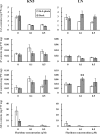Light Inhibition of Shoot Regeneration Is Regulated by Endogenous Abscisic Acid Level in Calli Derived from Immature Barley Embryos
- PMID: 26670930
- PMCID: PMC4682856
- DOI: 10.1371/journal.pone.0145242
Light Inhibition of Shoot Regeneration Is Regulated by Endogenous Abscisic Acid Level in Calli Derived from Immature Barley Embryos
Abstract
Shoot regeneration in calli derived from immature barley embryos is regulated by light conditions during the callus-induction period. Barley cultivars Kanto Nijo-5 (KN5) and K-3 (K3) showed lower efficiency of shoot regeneration in a 16-h photoperiod during callus-induction than those in continuous darkness, whereas shoot regeneration was enhanced in cultures under a 16-h photoperiod in Golden Promise (GP) and Lenins (LN). These cultivars were classified as photo-inhibition type (KN5 and K3) or photo-induction type (GP and LN) according to their response to light. Contents of endogenous plant hormones were determined in calli cultured under a 16-h photoperiod and continuous darkness. In photo-inhibition type, higher accumulation of abscisic acid (ABA) was detected in calli cultured under a 16-h photoperiod, whereas calli showed lower levels of endogenous ABA in continuous darkness. However, cultivars of photo-induction type showed lower levels of ABA in calli cultured under both light conditions, similarly to photo-inhibition type in continuous darkness. Exogenous ABA inhibited the callus growth and shoot regeneration independent of light conditions in all cultivars. In photo-inhibition type, lower levels of endogenous ABA induced by ABA biosynthesis inhibitor, fluridone, reduced the photo-inhibition of shoot regeneration. Expression of ABA biosynthesis gene, HvNCED1, in calli was regulated by the light conditions. Higher expression was observed in calli cultured under a 16-h photoperiod. These results indicate that ABA biosynthesis could be activated through the higher expression of HvNCED1 in a 16-h photoperiod and that the higher accumulations of ABA inhibit shoot regeneration in the photo-inhibition type cultivars.
Conflict of interest statement
Figures






References
-
- Kraepiel Y, Marrec K, Sotta B, Caboche M, Miginiac E (1995) In vitro morphogenic characteristics of phytochrome mutants in Nicotiana plumbaginifolia are modified and correlated to high indole-3-acetic acid levels. Planta 197: 142–146.
-
- Jiménez VM, Bangerth F (2001) Endogenous hormone levels in explants and in embryogenic and non-embryogenic cultures of carrot. Physiol Plant 111: 389–395. - PubMed
-
- Nakagawa H, Saijyo T, Yamauchi N, Shigyo M, Kako S, Ito A (2001) Effects of sugars and abscisic acid on somatic embryogenesis from melon (Cucumis melo L.) expanded cotyledon. Sci Hortic 92: 85–92.
-
- Kamal GB, Illich KG, Asadollah A (2007) Effects of genotype, explants type and nutrient medium components on canola (Brassica napus L.) shoot in vitro organogenesis. African J Biotechnol 6: 861–867.
-
- Hoang TG, Raldugina GN (2012) Regeneration of transgenic plants expressing the GFP gene from rape cotyledonary and leaf explants: Effects on the genotype and ABA. Russ J Plant Physiol 59: 406–412.
Publication types
MeSH terms
Substances
LinkOut - more resources
Full Text Sources
Other Literature Sources

